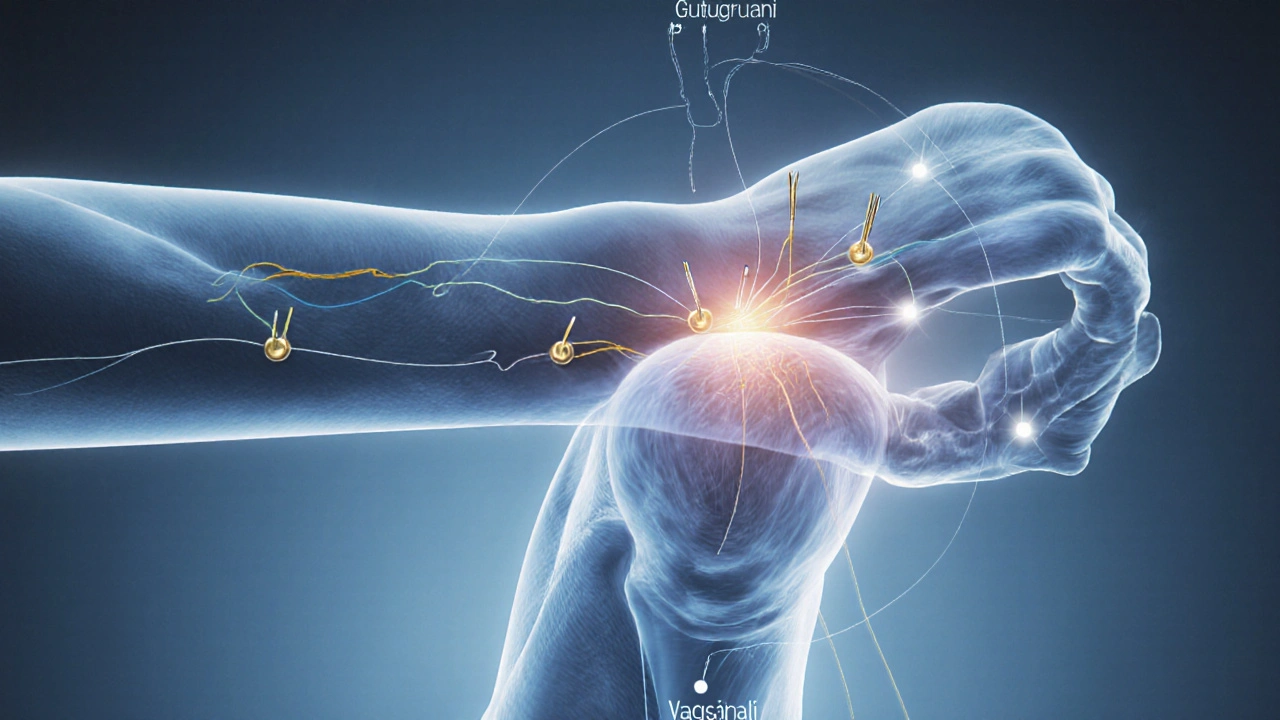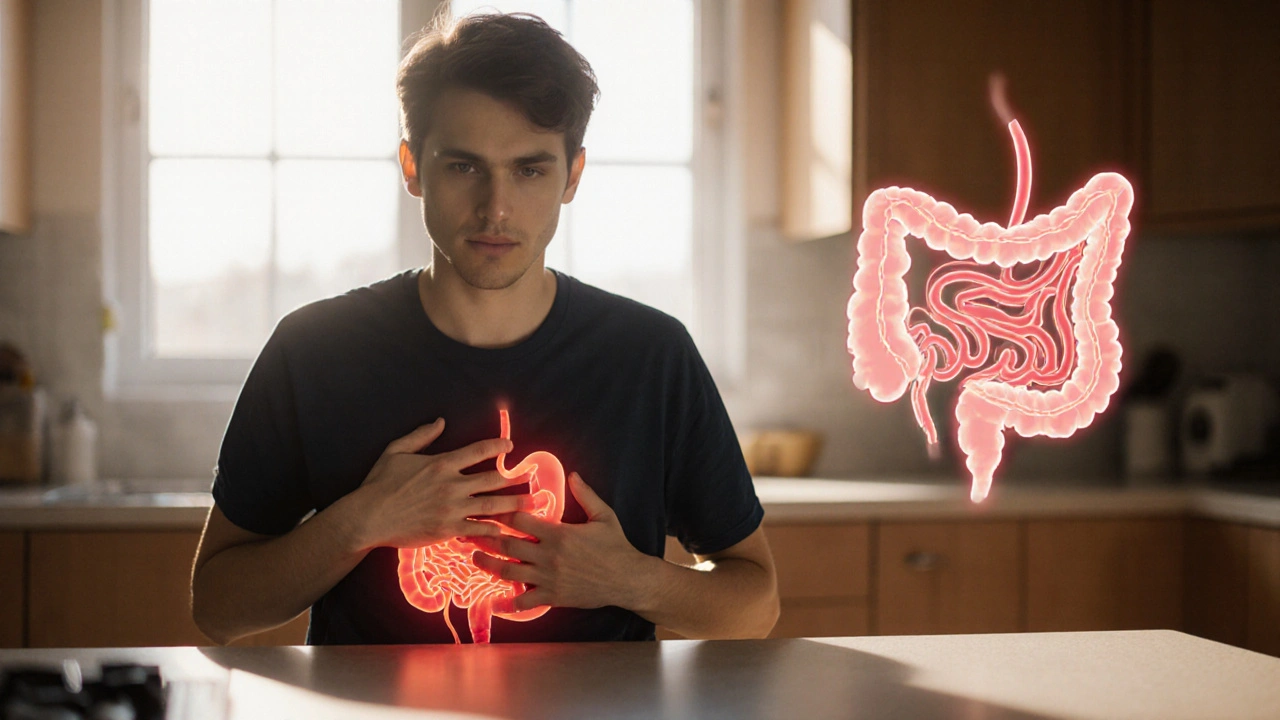Functional Dyspepsia Symptom Relief Calculator
Select Your Main Symptoms:
Estimated Symptom Relief:
Functional dyspepsia affects millions, causing lingering pain, bloating, and early fullness. While diet changes and meds help some, many look for gentler options. That's where Acupuncture a needle‑based therapy rooted in traditional Chinese medicine that aims to balance the body's energy flow comes into play. Recent research suggests it can ease the uncomfortable symptoms of functional dyspepsia without the side‑effects common to pharmaceuticals.
Key Takeaways
- Acupuncture targets the gut‑brain axis, improving gastric motility and reducing pain.
- Multiple randomized trials report modest but statistically significant symptom relief.
- Side‑effects are generally mild-bruising or temporary soreness.
- It works best when combined with dietary guidance and stress‑management techniques.
- Consult a licensed practitioner trained in treating gastrointestinal conditions.
Understanding Functional Dyspepsia
Functional dyspepsia a chronic disorder characterized by upper abdominal discomfort without an identifiable organic cause affects about 10 % of adults worldwide. The condition manifests as early satiety, post‑meal fullness, bloating, and burning pain. Because standard imaging often shows no ulcer or infection, doctors label it “functional,” meaning the symptoms arise from abnormal gut function rather than structural damage.
Current theories point to an impaired gut‑brain axis the two‑way communication network between the central nervous system and the gastrointestinal tract. Dysregulation of this axis can alter gastric motility, increase visceral hypersensitivity, and trigger inflammation. Lifestyle factors-stress, irregular meals, excessive caffeine-can exacerbate the loop.
How Acupuncture Influences the Digestive System
Acupuncture’s therapeutic effect is often explained in two complementary ways: the traditional meridian theory and modern neurophysiology.
From a Traditional Chinese Medicine a holistic system that maps health onto a network of energy pathways called meridians perspective, functional dyspepsia is linked to a blockage in the Stomach and Spleen meridians. Inserting needles at specific points-most commonly PC6 (Neiguan) and ST36 (Zusanli)-is believed to restore the flow of "Qi," thereby normalizing digestion.
Modern research shows that needle stimulation activates the vagus nerve the primary parasympathetic conduit linking brain and gut, which in turn modulates gastric emptying and reduces hypersensitivity. Functional MRI studies reveal that acupuncture at PC6 can increase activity in brain regions associated with pain inhibition, supporting a genuine physiological pathway.

Clinical Evidence for Symptom Relief
A 2023 systematic review published by the National Institutes of Health the U.S. agency that funds health research examined 12 randomized controlled trials (RCTs) involving over 1,200 participants with functional dyspepsia. The pooled data showed a 30 % greater reduction in symptom severity scores for acupuncture groups compared to sham‑acupuncture or standard care.
One double‑blind RCT conducted in Shanghai (2022) used a 6‑week protocol of twice‑weekly needle sessions at PC6, ST36, and LI4. Participants reported a mean decrease of 2.5 points on a 7‑point Likert scale for post‑prandial fullness, and 40 % achieved complete remission. The study’s authors highlighted a low dropout rate and minimal adverse events.
Another multi‑center trial in Germany (2021) compared acupuncture with a proton‑pump inhibitor (PPI). While PPIs improved acid‑related pain, acupuncture excelled in reducing bloating and early satiety, suggesting complementary mechanisms. The trial was funded by the World Health Organization the United Nations agency overseeing global health standards, reinforcing its methodological rigor.
Collectively, the evidence positions acupuncture as a viable adjunct, especially for patients who cannot tolerate or prefer to avoid long‑term medication.
What to Expect During an Acupuncture Session
First‑time visitors typically undergo a brief intake to discuss medical history, diet, and stress levels. A licensed practitioner will then select points based on the individualized pattern-most commonly PC6, ST36, CV12 (Zhongwan), and LI4.
Needles are ultra‑thin (0.2mm) and inserted to a depth of 5-15mm, depending on the point. You may feel a mild “tingling” or “de‑qi” sensation, which many patients describe as a warm rush. Sessions last 20-30minutes, and a course of 6-12 visits is standard for measurable improvement.
After treatment, patients often report a sense of relaxation, improved appetite, or reduced abdominal pressure. It’s advisable to stay hydrated and avoid heavy meals for an hour to maximize the therapeutic effect.
Safety Profile and Possible Side Effects
The most common Side effects unintended physical reactions such as bruising or soreness are minor bruising, transient soreness, or faintness-each occurring in less than 5 % of sessions.
Rare complications, such as infection or organ injury, are linked to improper needle handling. Therefore, ensure your therapist uses sterile, single‑use needles and follows universal precautions.
People with bleeding disorders, implanted electronic devices, or pregnancy should discuss contraindications beforehand. In most cases, adjustments to point selection mitigate risk.

Acupuncture vs. Conventional Treatments
| Aspect | Acupuncture | Proton‑Pump Inhibitors (PPIs) | Prokinetics (e.g., Domperidone) |
|---|---|---|---|
| Primary Mechanism | Modulates gut‑brain axis via vagal stimulation | Reduces gastric acid secretion | Enhances gastric motility |
| Onset of Relief | 2‑4 weeks (cumulative) | 1‑2 days | 1‑3 days |
| Typical Side Effects | Bruising, mild soreness | Headache, diarrhea, nutrient malabsorption | Cardiac arrhythmia, hormonal effects |
| Cost (US, per course) | $300‑$600 | $150‑$250 | $200‑$350 |
| Evidence Level | Moderate (RCTs, systematic reviews) | High (large RCTs) | Moderate (mixed trials) |
While medications provide faster symptom control, acupuncture offers a holistic benefit with fewer systemic risks, making it attractive for long‑term management.
Who May Benefit Most from Acupuncture?
If you fall into one of these categories, acupuncture could be a smart addition:
- Persistent dyspeptic symptoms despite diet changes and OTC antacids.
- Intolerance or contraindications to standard drugs (e.g., liver issues, pregnancy).
- High stress or anxiety levels that seem to flare digestive discomfort.
- Preference for natural, low‑chemical interventions.
Always coordinate with your gastroenterologist to ensure an integrated care plan.
Frequently Asked Questions
How many acupuncture sessions are needed to see improvement?
Most studies report noticeable symptom reduction after 6-8 sessions, typically administered twice a week. Some patients continue with monthly maintenance to sustain benefits.
Is acupuncture covered by health insurance?
Coverage varies by country and plan. In the United States, many Medicare Advantage and private plans include acupuncture for chronic pain, but you’ll need a referral and a licensed practitioner.
Can I combine acupuncture with my current medication?
Yes. Acupuncture is generally safe alongside PPIs or prokinetics, but inform your doctor so they can monitor any interaction or overlapping side effects.
What should I avoid after an acupuncture session?
Avoid heavy meals, alcohol, and intense exercise for at least an hour. Stay hydrated and allow the body to rest, which helps the therapeutic signal settle.
Is there scientific proof that acupuncture works for digestion?
Multiple randomized controlled trials and a 2023 NIH meta‑analysis demonstrate statistically significant relief of dyspepsia symptoms, supporting a physiologic basis beyond placebo.
When used thoughtfully, acupuncture offers a gentle, evidence‑backed path to calmer stomachs and fewer pills.


Ralph Louis
October 7, 2025 AT 15:33Acupuncture is just another fad marketed to the desperate.
Angela Allen
October 7, 2025 AT 17:13i totally feel you on trying to find something that actually helps without the harsh meds.
i’ve read a bunch about gut‑brain axis stuff and it kinda makes sense.
plus, needles sound scary but they’re super thin, so most people don’t even feel a lot.
if you’re thinking about giving it a shot, make sure the practitioner is legit and uses single‑use needles.
stay hydrated after and avoid heavy meals for an hour, that seems to help a lot.
Christopher Jimenez
October 7, 2025 AT 18:45While the layperson’s enthusiasm for acupuncture may appear charmingly naive, a rigorous examination reveals several critical nuances that merit discussion.
First, the purported mechanism of "Qi" redistribution is fundamentally at odds with the principles of evidence‑based physiology, rendering the explanatory model scientifically untenable.
Second, the meta‑analysis cited in the post, though impressive on its surface, suffers from heterogeneity in trial design, blinding protocols, and outcome measures, which inflates the apparent effect size.
Third, many of the cited trials employ sham‑acupuncture controls that are not truly inert, thereby confounding the distinction between specific and nonspecific therapeutic effects.
Fourth, the vagal activation hypothesis, while plausible, remains speculative without direct neurophysiological corroboration in large‑scale human studies.
Fifth, the cost–benefit calculus is nontrivial; a twelve‑session course often exceeds $500, which is a substantial outlay for marginal gains.
Sixth, adverse events, albeit rare, include pneumothorax and infections when aseptic technique lapses, underscoring the necessity of stringent practitioner credentialing.
Seventh, the literature reveals a publication bias favoring positive outcomes, with negative studies less likely to appear in mainstream databases.
Eighth, the cultural import of acupuncture may predispose patients to expectancy effects, further muddying the interpretation of subjective symptom relief.
Ninth, regulatory oversight varies dramatically across jurisdictions, meaning a “licensed” practitioner in one country may lack comparable training elsewhere.
Tenth, the integration of acupuncture with conventional pharmacotherapy warrants systematic evaluation to rule out synergistic toxicity.
Eleventh, the discontinuation rates in many trials are not reported, obscuring real-world adherence challenges.
Twelfth, the follow‑up periods are generally short, providing limited insight into the durability of symptom amelioration.
Thirteenth, the sample sizes, though cumulatively exceeding a thousand participants, are fragmented across heterogeneous protocols, limiting statistical power.
Fourteenth, the reported 30 % improvement is often relative to a low baseline, which translates to modest absolute symptom reductions.
Fifteenth, the neuroimaging findings of altered brain activity are intriguing yet remain correlative rather than causative.
In conclusion, while acupuncture may offer a placebo‑enhanced adjunct for functional dyspepsia, its adoption should be predicated on a discerning appraisal of the methodological limitations and a transparent discussion with patients regarding realistic expectations.
Olivia Christensen
October 7, 2025 AT 20:20Wow, that was a marathon of a comment! 😅 I see where you’re coming from – the evidence is definitely a mixed bag.
At the end of the day, if someone feels better and isn’t getting hurt, that’s pretty cool.
But I do think it’s smart to keep an eye on the quality of the studies and not just the headline numbers.
Balance is key, right?
Lauren W
October 7, 2025 AT 21:56Let us not be dazzled by the superficial allure of needles; the true art lies in rigorous skepticism.
We must question who profits from this so‑called “alternative” wave and whether the hype eclipses genuine therapeutic value.
In an era where pseudoscience masquerades as wellness, conscientious assessment is a moral imperative.
Crystal Doofenschmirtz
October 7, 2025 AT 23:30Interesting perspective. While I acknowledge the need for critical appraisal, I also think it’s important to respect patient autonomy.
If an individual feels benefit and the practice meets safety standards, dismissing it outright could be paternalistic.
Pankaj Kumar
October 8, 2025 AT 01:08Hey folks, just wanted to add that many traditional therapies, including acupuncture, have roots in centuries‑old observations of the body’s response to stimuli.
When integrated thoughtfully with modern diagnostics, they can complement conventional care.
Remember to choose a practitioner who has specific training in gastrointestinal disorders.
sneha kapuri
October 8, 2025 AT 02:43Sure, “centuries‑old observations” are just romantic nonsense that lets big‑pill companies keep their profits safe.
If you’re not willing to demand high‑quality RCTs, you’re feeding the illusion.
Stop selling hope for a few bucks and demand real science.
Harshitha Uppada
October 8, 2025 AT 04:16i think ur both missing the point, u cant just toss out ancient stuff cuz its old.
some ppl just need sumthin to feel better, even if it’s just a placebo lol.
Randy Faulk
October 8, 2025 AT 05:53While anecdotal improvements are noteworthy, it is essential to contextualize them within the framework of evidence‑based medicine.
Clinical guidelines recommend acupuncture as an adjunct rather than a primary therapy for functional dyspepsia.
Patients should continue to follow dietary modifications and, when appropriate, pharmacologic interventions.
Brandi Hagen
October 8, 2025 AT 07:33Listen up, America! Our gut health is under attack from the same pharmaceutical giants that want us glued to endless prescriptions.
Acupuncture is a home‑grown, drug‑free solution that empowers us to take back control.
Don’t let the establishment dictate how you feel; demand access to acupuncture coverage now! 🇺🇸💪
isabel zurutuza
October 8, 2025 AT 09:05sure, because nothing screams "patriotic" like poking yourself with needles.
James Madrid
October 8, 2025 AT 10:43Hey team, I’ve seen a few patients who combined acupuncture with a low‑FODMAP diet and reported noticeable relief.
If you’re considering it, aim for 6‑8 sessions first and reassess how you feel.
Keep a symptom diary; objective data helps you and your practitioner fine‑tune the approach.
Justin Valois
October 8, 2025 AT 12:16Yo, that sounds like a cookie‑cutter plan that any American‑made wellness blog would push.
We need real numbers, not just “keep a diary.”
Also, who’s funding these studies? Probably the same folks pushing vitamins and supplements.
Ask for raw data before you buy into the hype.
Jessica Simpson
October 8, 2025 AT 13:51From a cultural perspective, many societies have long embraced needle therapies as part of holistic health.
It’s fascinating to see how modern research begins to map these practices onto neurophysiological pathways.
I’d love to hear more about cross‑cultural studies comparing outcomes.
Ryan Smith
October 8, 2025 AT 15:23Sure, until the next “secret agenda” reveals that the needles are actually micro‑chips. 🙄
John Carruth
October 8, 2025 AT 17:01All right, everyone-let's keep this constructive!
We all want relief from functional dyspepsia without piling on meds that bring side effects.
Acupuncture can be a viable part of a multimodal plan, but it shouldn't replace proven treatments when those are indicated.
Talk to your gastroenterologist, get a solid diagnosis, and then discuss integrative options together.
That collaborative approach ensures safety and maximizes benefit.
Melodi Young
October 8, 2025 AT 18:35hey john, totally agree-teamwork makes the dream work!
also, if anyone's curious about where to find a qualified acupuncturist, I've got a few referrals from my clinic.
Tanna Dunlap
October 8, 2025 AT 20:11We must not forget that promoting any treatment without stringent peer‑reviewed evidence borders on ethical negligence.
Patients deserve transparency about both benefits and limitations.
Troy Freund
October 8, 2025 AT 21:46Agreed. While critical appraisal is essential, let’s also respect individual experiences.
For many, the ritual of acupuncture adds a mindfulness component that alone can ease stress‑related gut symptoms.
Balancing scientific rigor with patient‑centered care is the way forward.